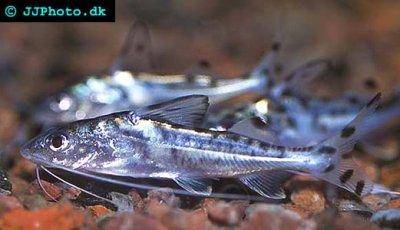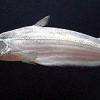Pictus catfish - Pimelodus pictus
Scientific name: Pimelodus pictus
Common name: Pictus catfish
Family: Pimelodidae
Usual size in fish tanks: 10 - 12 cm (3.94 - 4.72 inch)
014
Recommended pH range: 6.5 - 7.5
Recommended water hardness: 4 - 18°N (71.43 - 321.43ppm)
0°C 32°F30°C 86°F
Recommended temperature range: 23 - 27 °C (73.4 - 80.6°F)
The way how these fish reproduce: Spawning
Where the species comes from: South America
Temperament to its own species: peaceful
Temperament toward other fish species: aggressive to smaller
Usual place in the tank: Bottom levels
Food and feeding
The Pictus catfish (Pimelodus pictus) is a voracious bottom-feeder. It will accept most foods that sink to the substrate – from specialized catfish pellets and quality flakes to live or frozen offerings like bloodworms, chopped earthworms, brine shrimp, and daphnia. Be careful not to overfeed; pictus catfish have a reputation for eating relentlessly until they appear bloated. Feed modest portions 1–2 times per day, ensuring faster fish in the tank do not outcompete them.
Origin
Native to South America, specifically the Orinoco basin (Colombia, Venezuela) and the Amazon basin (Peru, Brazil). They prefer shallow, flowing waters with sandy or muddy bottoms.
Sexing
Females are generally larger and rounder-bodied than males, especially when mature.
Breeding
Although egg-layers in the wild, successful breeding in home aquaria is extremely rare. They require very large tanks, deep substrate, and stable water chemistry. Professional aquaculture farms sometimes induce spawning hormonally.
Lifespan
With good care, Pimelodus pictus can live up to 8–10 years. They are sensitive to poor water quality, medications, and chemicals. If water parameters drop, their delicate barbels may erode – but will regrow once conditions improve.
Tank requirements
- Tank size: minimum 150 L (40 gallons) per fish; larger setups are strongly recommended.
- Substrate: soft sand or smooth gravel (sharp edges damage their sensitive barbels).
- Aquascape: dim lighting, caves, driftwood, and hardy plants; leave open areas for swimming.
- Filtration: powerful, as pictus catfish produce significant waste.
A clean, well-oxygenated aquarium is essential. Poor water leads to barbel erosion and stress.
Tankmates
Pictus catfish are peaceful but opportunistic predators. They will eat any fish small enough to fit in their mouths (guppies, small tetras, fry, juvenile Corydoras). Suitable companions are similar-sized active fish such as robust cichlids, larger barbs, or peaceful catfish. Avoid slow-moving species with long fins, which may be harassed.
Handling
Never use a mesh net – their sharp dorsal spines easily tangle and break. Instead, use a smooth container (glass or cut plastic jug) to transfer them. Their spines are coated with a mild toxin that causes pain and swelling, so always handle with extreme care.
Short description
Two regional variants exist: Colombian specimens with fine black spots and Peruvian forms with larger spots. Their striking spotted pattern and active nature make them popular, but their size, waste production, and appetite require serious commitment.
FAQ
Why does my pictus catfish have white spots?
White spots are often a sign of Ich (white spot disease). Raise the temperature slightly, add aquarium salt, and use a safe Ich medication. Treat cautiously, as pictus catfish are sensitive to chemicals.
Pictures
Bought by aqua-fish.net from jjphoto.dk.







 Jello
Jello  Highwaterman
Highwaterman  Spotted
Spotted  Ornate
Ornate  Tiger
Tiger